Automatic and Generic Prognosis Method Based on Data Trend Analysis and Neural Network
Abstract
:1. Introduction
- Automatic relevant data identification based on signal smoothing and trendability analysis.
- Automatic degradation model identification for HIs construction, built using an offline trained neural network, thus allowing for the automatic adaptation of the degradation trend model to changes in the degradation dynamic.
2. Related Works
3. Overview of the Proposed Approach
3.1. Offline Stage
3.1.1. Signal Smoothing
3.1.2. Trend Analyses
- H: no monotonic trend;
- HA: a monotonic trend is present.
3.1.3. Degradation Fit Model
3.1.4. Model Training
3.2. Online Stage
3.2.1. Health Indices Construction
3.2.2. Failure Prognosis
4. Application to Turbofan Engine: A Case Study
5. Results and Discussion
- Accuracy metrics such as RMSE;
- Prognostics metrics such as and relative accuracy.
- There is no expert supervision in the choice of training variables: by using the proposed approach, the most trended signal in data set 1 is sensor 3: T30. This sensor is related to the HPC and to the degradation in data set 1 [43]. The trend analyses can find without any prior knowledge the sensors which are related to the degradation and which can be used as HIs.
- The degradation model is determined using RMSE and R-squared metrics, among multiple predefined fitting functions (sum of sin, power, exponential, Gaussian, etc.). Considering C-MAPSS data, the degradation model was identified to follow an exponential trend as it was considered in the damage propagation model [43].
- The failure prognosis results depend on whether the run-to-failure data are complete or not, i.e, in the case of run-to-failure data, the estimated HI is near the EOL, so the degradation state is clear and a fit of HI will estimate a good EOL. However, in the case of non-complete data, the degradation trajectory and the EOL are hard to drive.
- The presented approach is a generic one, and it can be applied on any time series data with neither knowledge of system dynamics nor expert intervention.
6. Conclusions
Author Contributions
Funding
Institutional Review Board Statement
Informed Consent Statement
Data Availability Statement
Conflicts of Interest
Appendix A
| Symbol | Description | Unit | |
|---|---|---|---|
| Unit | / | / | / |
| Time | / | / | t |
| Setting 1 | / | Altitude | ft |
| Setting 2 | / | Mach number | M |
| Setting 3 | / | Sea-level temperature | °F |
| Sensor 1 | T2 | Total temperature at fan inlet | °R |
| Sensor 2 | T24 | Total temperature at LPC outlet | °R |
| Sensor 3 | T30 | Total temperature at HPC outlet | °R |
| Sensor 4 | T50 | Total temperature at LPT outlet | °R |
| Sensor 5 | P2 | Pressure at fan inlet | Psia |
| Sensor 6 | P15 | Total pressure in bypass duct | Psia |
| Sensor 7 | P30 | Total pressure at HPC outlet | Psia |
| Sensor 8 | Nf | Physical fan speed | rpm |
| Sensor 9 | Nc | Phsical core speed | rpm |
| Sensor 10 | epr | Engine pressure ratio | / |
| Sensor 11 | Ps30 | Static pressure at HPC outlet | Psia |
| Sensor 12 | phi | Ratio of fuel flow to PS30 | pps |
| Sensor 13 | NRf | Corrected fan speed | rpm |
| Sensor 14 | NRc | Corrected core speed | rpm |
| Sensor 15 | BPR | Bypass ratio | / |
| Sensor 16 | farB | Burner fuel-air ratio | / |
| Sensor 17 | htBleed | Bleed enthalpy | / |
| Sensor 18 | Nf-dmd | Demanded fan speed | rpm |
| Sensor 19 | PCNfR-dmd | Demanded corrected fan speed | rpm |
| Sensor 20 | W31 | HPT coolant bleed | lbm/s |
| Sensor 21 | W32 | LPT coolant bleed | lbm/s |
| Characteristics | Data Set Number | |||
|---|---|---|---|---|
| 1 | 2 | 3 | 4 | |
| Number of faults | 1 | 1 | 2 | 2 |
| Operation conditions | 1 | 6 | 1 | 6 |
| N° of training data engines | 100 | 260 | 100 | 249 |
| N° of test data engines | 100 | 259 | 100 | 248 |
References
- Djeziri, M.; Benmoussa, S.; Zio, E. Artificial Intelligence Techniques for a Scalable Energy Transition. In Artificial Intelligence Techniques for a Scalable Energy Transition: Advanced Methods, Digital Technologies, Decision Support Tools, and Applications; Sayed-Mouchaweh, M., Ed.; Chapter Review on Health Indices Extraction and Trend Modeling for Remaining Useful Life Estimation; Springer International Publishing: Cham, Switzerland, 2020; pp. 183–223. [Google Scholar]
- Meng, H.; Li, Y.F. A review on prognostics and health management (PHM) methods of lithium-ion batteries. Renew. Sustain. Energy Rev. 2019, 116, 109405. [Google Scholar] [CrossRef]
- Sun, J.; Zuo, H.; Wang, W.; Pecht, M. Application of a state space modeling technique to system prognostics based on a health index for condition-based maintenance. Mech. Syst. Signal Process. 2012, 28, 585–596. [Google Scholar] [CrossRef]
- Cai, J.; Ferdowsi, H.; Jagannathan, S. Model-based fault detection, estimation, and prediction for a class of linear distributed parameter systems. Automatica 2016, 66, 122–131. [Google Scholar] [CrossRef] [Green Version]
- Bagheri, M.; Nezhivenko, S.; Naderi, M.S.; Zollanvari, A. A new vibration analysis approach for transformer fault prognosis over cloud environment. Electr. Power Energy Syst. 2018, 100, 104–116. [Google Scholar] [CrossRef]
- Zhang, L.; Mu, L.; Sun, C. Remaining Useful Life Prediction for Lithium-Ion Batteries Based on Exponential Model and Particle Filter. IEEE Access 2018, 6, 17729–17740. [Google Scholar] [CrossRef]
- Zhao, F.; Tian, Z.; Zeng, Y. Uncertainty Quantification in Gear Remaining Useful Life Prediction Through an Integrated Prognostics Method. IEEE Trans. Reliab. 2013, 62, 146–159. [Google Scholar] [CrossRef]
- Li, J.; Tian, Y.; Wang, D. Change-point detection of failure mechanism for electronic devices based on Arrhenius model. Appl. Math. Model. 2020, 83, 46–58. [Google Scholar] [CrossRef]
- Paris, P.; Erdogan, F. A Critical Analysis of Crack Propagation Laws. J. Basic Eng. 1963, 85, 528–533. [Google Scholar] [CrossRef]
- Djeziri, M.A.; Benmoussa, S.; Sanshez, R. Hybrid method for remaining useful life prediction in wind turbine systems. Renew. Energy 2017, 116, 173–187. [Google Scholar] [CrossRef]
- Benmoussa, S.; Djeziri, M. Remaining useful life estimation without needing for prior knowledge of the degradation features. IET Sci. Meas. Technol. 2017, 11, 1071–1078. [Google Scholar] [CrossRef]
- Jahromi, A.T.; Er, M.J.; Li, X.; Lim, B.S. Sequential fuzzy clustering based dynamic fuzzy neural network for fault diagnosis and prognosis. Neurocomputing 2016, 196, 31–41. [Google Scholar] [CrossRef]
- Rai, A.; Upadhyay, S. The use of MD-CUMSUM and NARX neural network for anticipating the remaining useful life of bearings. Measurement 2017, 111, 397–410. [Google Scholar] [CrossRef]
- Pandiyan, V.; Caesarendra, W.; Tjahjowidodo, T.; Tana, H. In-process tool condition monitoring in compliant abrasive belt grinding process using support vector machine and genetic algorithm. J. Manuf. Process. 2018, 31, 199–213. [Google Scholar] [CrossRef]
- Benmoussa, S.; Djeziri, M.; Sanchez, R. Chapter Support vector machine classification of current data for fault diagnosis and similarity-based approach for failure prognosis in wind turbine systems. In Artificial Intelligence Techniques for a Scalable Energy Transition; Springer: Cham, Switzerland, 2020; pp. 157–182. [Google Scholar]
- Wang, X.; Jiang, B.; Lu, N.; Zhang, C. Dynamic fault prognosis for multivariate degradation process. Neurocomputing 2018, 275, 1112–1120. [Google Scholar] [CrossRef]
- Saidi, L.; Ali, J.B.; Bechhoefer, E.; Benbouzid, M. Wind turbine high-speed shaft bearings health prognosis through a spectral Kurtosis-derived indices and SVR. Appl. Acoust. 2017, 120, 1–8. [Google Scholar] [CrossRef]
- Zhang, Z.; Si, X.; Hu, C.; Lei, Y. Degradation data analysis and remaining useful life estimation: A review on Wiener-process-based methods. Eur. J. Oper. Res. 2018, 271, 775–796. [Google Scholar] [CrossRef]
- Susto, G.A.; Schirru, A.; Pampuri, S.; Beghi, A.; Nicolao, G.D. A hidden-Gamma model-based filtering and prediction approach for monotonic health factors in manufacturing. Control Eng. Pract. 2018, 74, 84–94. [Google Scholar] [CrossRef]
- Nguyen, L.; Djeziri, M.; Ananou, B.; Ouladsine, M.; Pinaton, J. Fault prognosis for batch production based on percentile measure and gamma process: Application to semiconductor manufacturing. J. Process Control 2016, 48, 72–80. [Google Scholar] [CrossRef]
- Liu, Q.; Dong, M.; Lv, W.; Geng, X.; Li, Y. A novel method using adaptive hidden semi-Markov model for multi-sensor monitoring equipment health prognosis. Mech. Syst. Signal Process. 2015, 64–65, 217–232. [Google Scholar] [CrossRef]
- Cai, B.P.; Yang, C.; Liu, Y.H.; Kong, X.D.; Gao, C.T.; Tang, A.B.; Liu, Z.K.; Ji, R.J. A data-driven early micro-leakage detection and localization approach of hydraulic systems. J. Cent. South Univ. 2021, 23, 1390–1401. [Google Scholar] [CrossRef]
- Hu, J.; Zhang, L.; Tian, W.; Zhou, S. DBN based failure prognosis method considering the response of protective layers for the complex industrial systems. Eng. Fail. Anal. 2017, 79, 504–519. [Google Scholar] [CrossRef]
- Liao, L.; Köttig, F. Review of Hybrid Prognostics Approaches for Remaining Useful Life Prediction of Engineered Systems, and an Application to Battery Life Prediction. IEEE Trans. Reliab. 2014, 63, 191–207. [Google Scholar] [CrossRef]
- Guerra de Araujo Cruz, A.; Delgado Gomes, R.; Antonio Belo, F.; Cavalcante Lima Filho, A. A Hybrid System Based on Fuzzy Logic to Failure Diagnosis in Induction Motors. IEEE Lat. Am. Trans. 2017, 15, 1480–1489. [Google Scholar] [CrossRef]
- Garga, A.; McClintic, K.; Campbell, R.; Yang, C.; Lebold, M.; Hay, T.; Byington, C. Hybrid reasoning for prognostic learning in CBM systems. IEEE Aerosp. Conf. Proc. 2001, 6, 62957–62969. [Google Scholar] [CrossRef]
- García-Nieto, P.J.; García-Gonzalo, E.; Sánchez Lasheras, F.; de Cos Juez, F. Hybrid PSO–SVM-based method for forecasting of the remaining useful life for aircraft engines and evaluation of its reliability. Reliab. Eng. Syst. Saf. 2015, 138, 219–231. [Google Scholar] [CrossRef]
- Dourado, A.; Viana, F.A.C. Physics-informed neural networks for missing physics estimation in cumulative damage models: A case study in corrosion fatigue. ASME J. Comput. Inf. Sci. Eng. 2020, 20, 061007. [Google Scholar] [CrossRef]
- Porotsky, S. Prognostic and Health Management: God Is in Details. In Proceedings of the Reliability and Maintainability Symposium, Las Vegas, NV, USA, 25–28 January 2016. [Google Scholar]
- Bektas, O.; Jones, J.A. NARX Time Series Model for Remaining Useful Life Estimation of Gas Turbine Engines. In Proceedings of the European Conference of the Prognostics and Health Management Society, Bilbao, Spain, 5–8 July 2016. [Google Scholar]
- Coble, J.; Hines, J.W. Chapter Identifying Suitable Degradation Parameters for Individual-Based Prognostics. In Diagnostics and Prognostics of Engineering Systems: Methods and Techniques; IGI Global: Hershey, PA, USA, 2012; pp. 135–150. [Google Scholar]
- Savitzky, A.; Golay, M.J. Smoothing and differentiation of data by simplified least squares procedures. Anal. Chem. 1964, 36, 1627–1639. [Google Scholar] [CrossRef]
- Dombi, J.; Dineva, A. Adaptive Multi-round Smoothing Based on the Savitzky-Golay Filter. In International Workshop Soft Computing Applications; Springer: Cham, Switzerland, 2018. [Google Scholar]
- Zhu, G.F.; Zhu, H.Q.; Yang, C.H.; Gui, W.H. Improved Savitzky-Golay filtering algorithm for measuring a pharmaceutical vial’s oxygen content based on wavelength modulation spectroscopy. J. Opt. Technol. 2017, 84, 355–359. [Google Scholar] [CrossRef]
- Rossini, A. Chapter Applied Smoothing Techniques for Data Analysis: The Kernel Approach with S-Plus Illustrations. In Computational Statistics; John Wiley & Sons: Hoboken, NJ, USA, 2000; Volume 15, pp. 301–302. [Google Scholar]
- Rutkowska, A. Properties of the Cox-Stuart Test for Trend in Application to Hydrological Series: The Simulation Study. Commun. Stat. Simul. Comput. 2015, 44, 565–579. [Google Scholar] [CrossRef]
- Mann, H. Non-parametric tests against trend. Econometrica 1945, 13, 163–171. [Google Scholar] [CrossRef]
- Heimes, F.O. Recurrent neural networks for remaining useful life estimation. In Proceedings of the 2008 International Conference on Prognostics and Health Management, Denver, CO, USA, 6–9 October 2008; pp. 1–6. [Google Scholar] [CrossRef]
- Bektas, O.; Jones, J.; Sankararaman, S.; Roychoudhury, I.; Goebel, K. A neural network framework for similarity-based prognostics. MethodsX 2019, 6, 383–390. [Google Scholar] [CrossRef] [PubMed]
- Listou Ellefsen, A.; Bjørlykhaug, E.; Æsøy, V.; Ushakov, S.; Zhang, H. Remaining useful life predictions for turbofan engine degradation using semi-supervised deep architecture. Reliab. Eng. Syst. Saf. 2019, 183, 240–251. [Google Scholar] [CrossRef]
- Jiujian, W.; Guilin, W.; Shaopu, Y.; Yongqiang, L. Remaining Useful Life Estimation in Prognostics Using Deep Bidirectional LSTM Neural Network. In Proceedings of the Prognostics and System Health Management Conference, Chongqing, China, 26–28 October 2018. [Google Scholar]
- Khelif, R.; Malinowski, S.; Chebel-Morello, B.; Zerhouni, N. RUL prediction based on a new similarity-instance based approach. In Proceedings of the 2014 IEEE 23rd International Symposium on Industrial Electronics (ISIE), Istanbul, Turkey, 1–4 June 2014; pp. 2463–2468. [Google Scholar] [CrossRef] [Green Version]
- Saxena, A.; Goebel, K.; Simon, D.; Eklund, N. Damage Propagation Modeling for Aircraft Engine Run-to-Failure Simulation. In Proceedings of the Ist International Conference on Prognostics and Health Management, Denver, CO, USA, 6–9 October 2008. [Google Scholar]
- Ramasso, E. Investigating computational geometry for failure prognostics in presence of imprecise health indicator: Results and comparisons on CMAPSS datasets. In Proceedings of the European Conference of the Prognostics and Health Management Society, Nantes, France, 8–10 July 2014. [Google Scholar]
- Laredo, D.; Chen, Z.; Schutze, O.; Sun, J.Q. A Neural Network-Evolutionary Computational Framework for Remaining Useful Life Estimation of Mechanical Systems. Neural Netw. 2019, 116, 178–187. [Google Scholar] [CrossRef] [PubMed] [Green Version]
- Peng, Y.; Wang, H.; Wang, J.; Liu, D.; Peng, X. A modified echo state network based remaining useful life estimation approach. In Proceedings of the 2012 IEEE Conference on Prognostics and Health Management, Denver, CO, USA, 18–21 June 2012; pp. 1–7. [Google Scholar] [CrossRef]
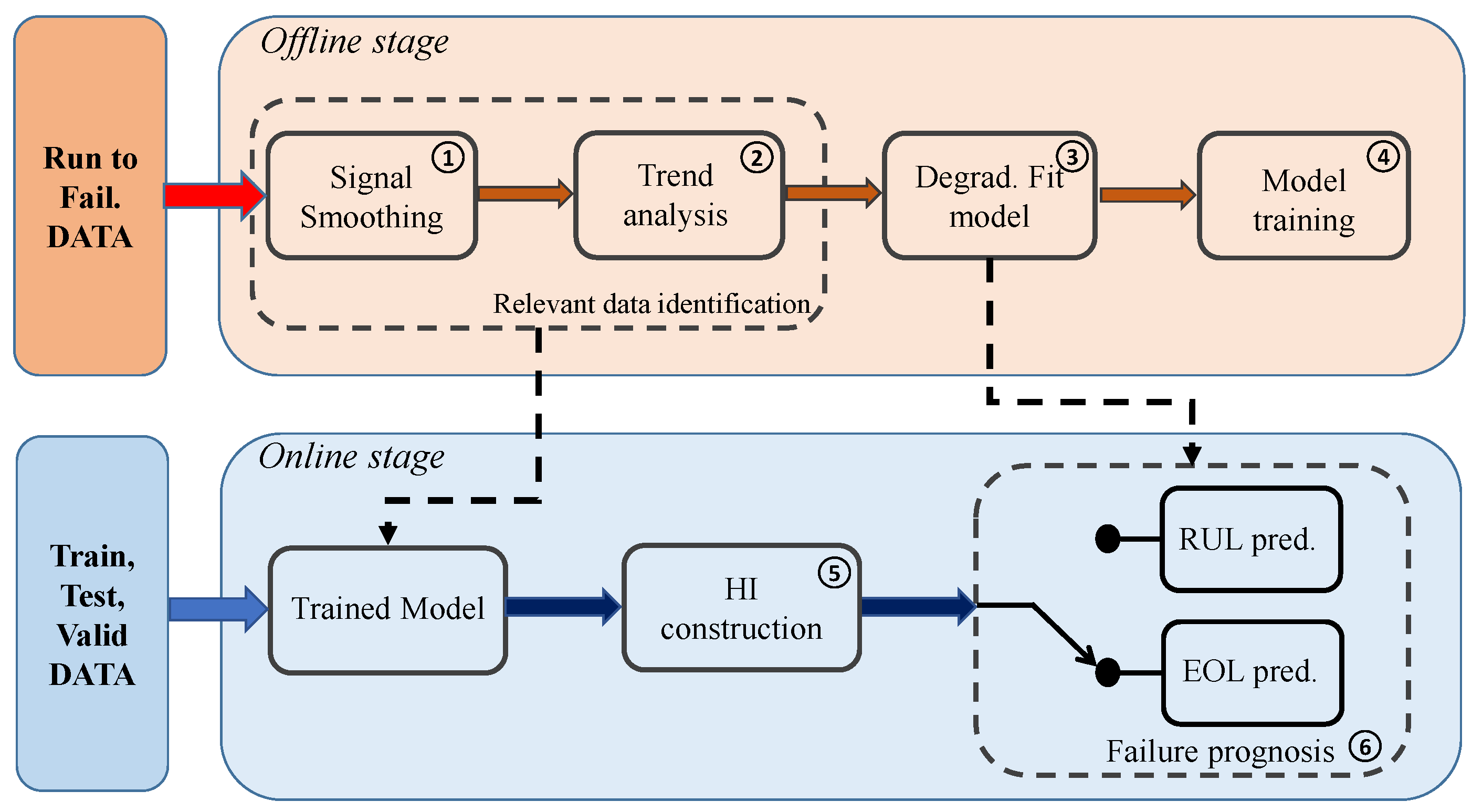

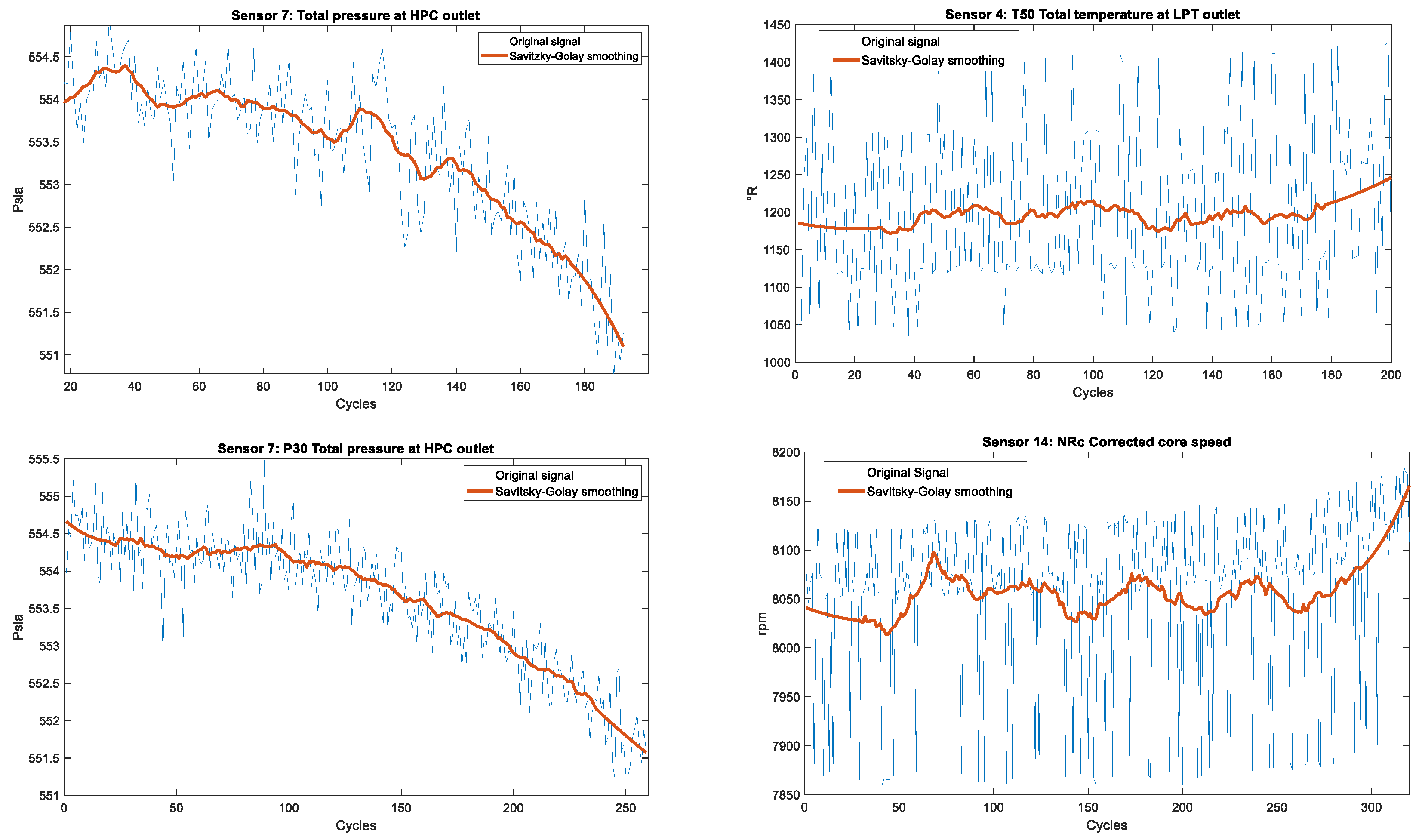

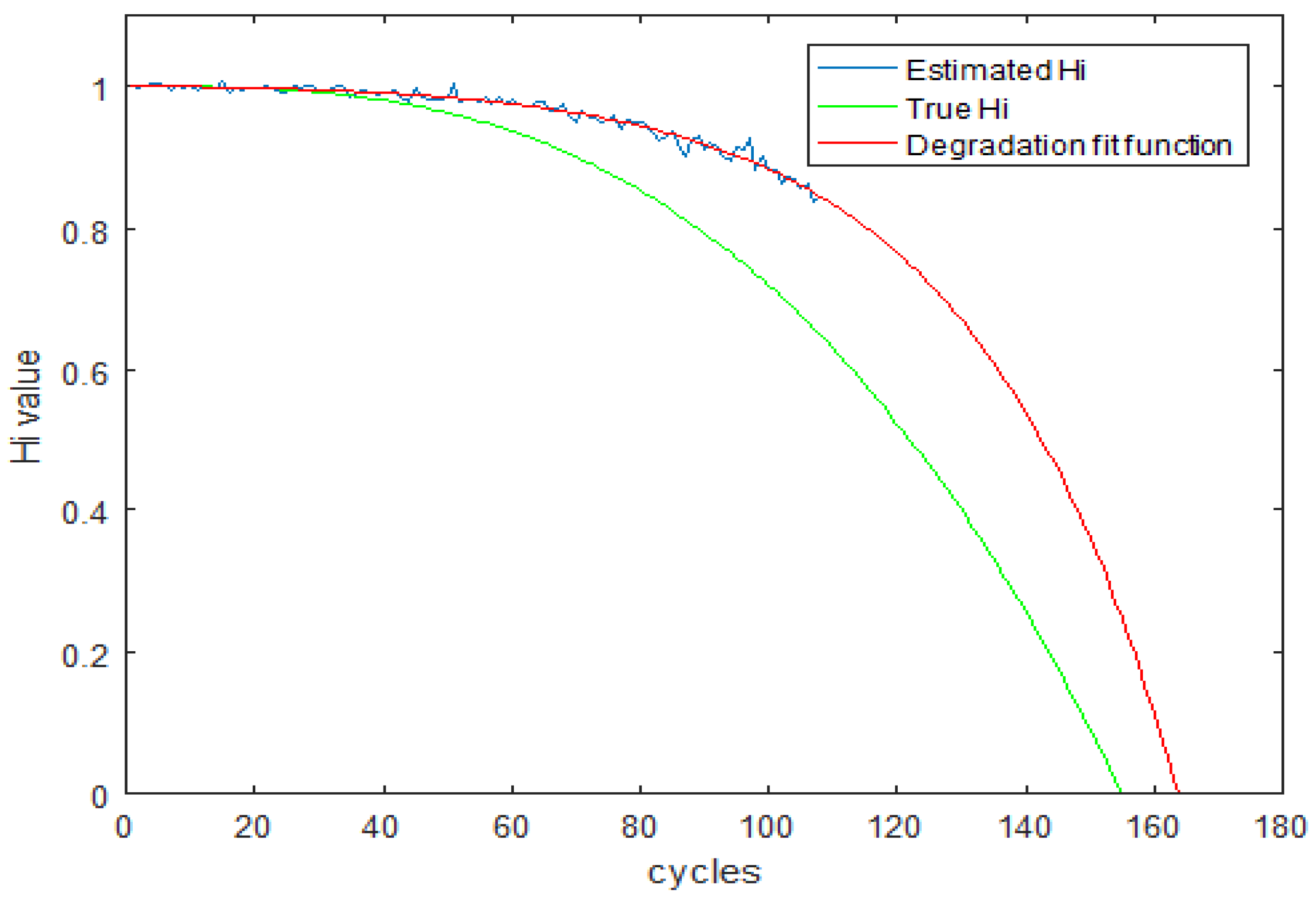
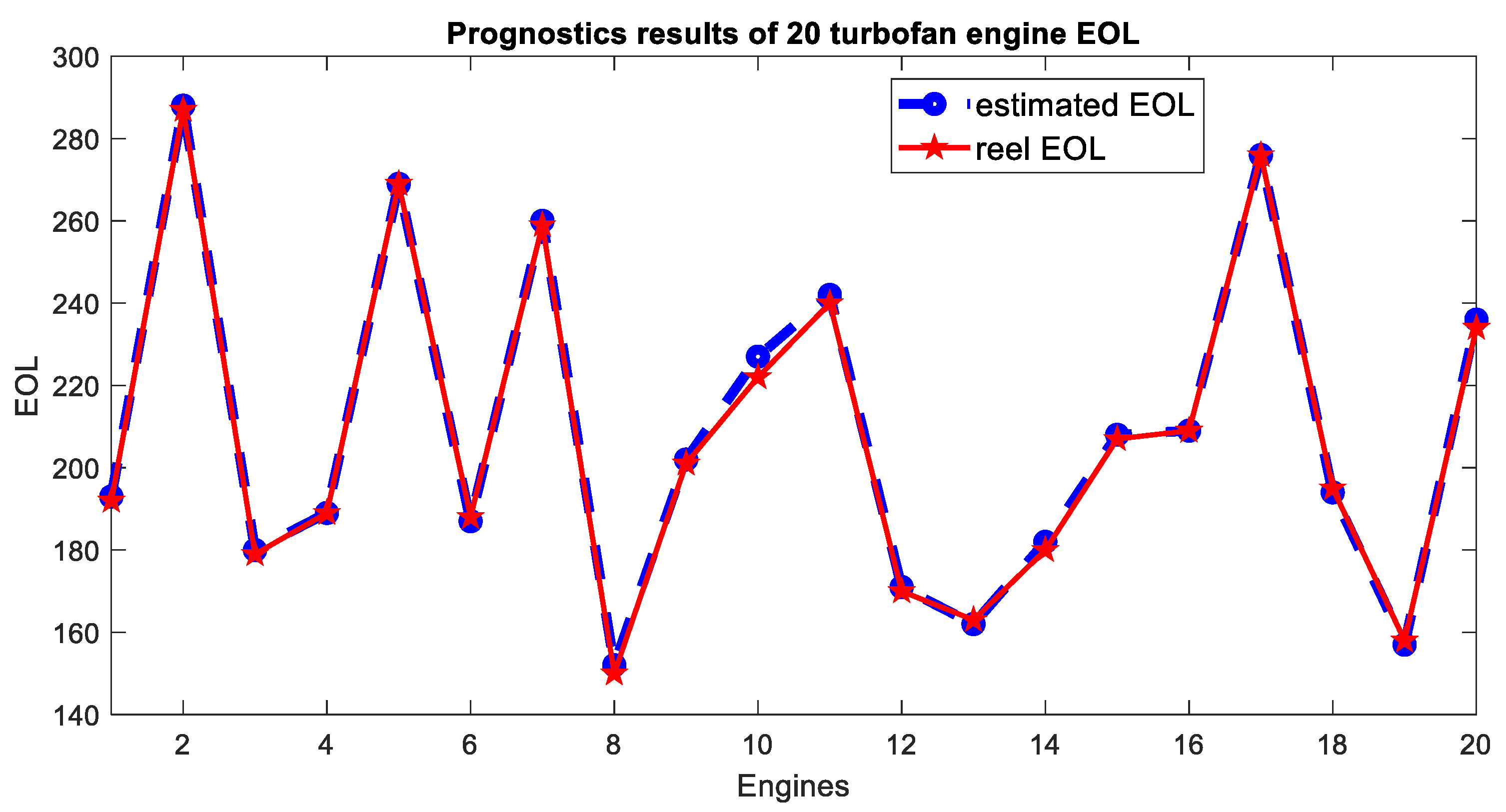
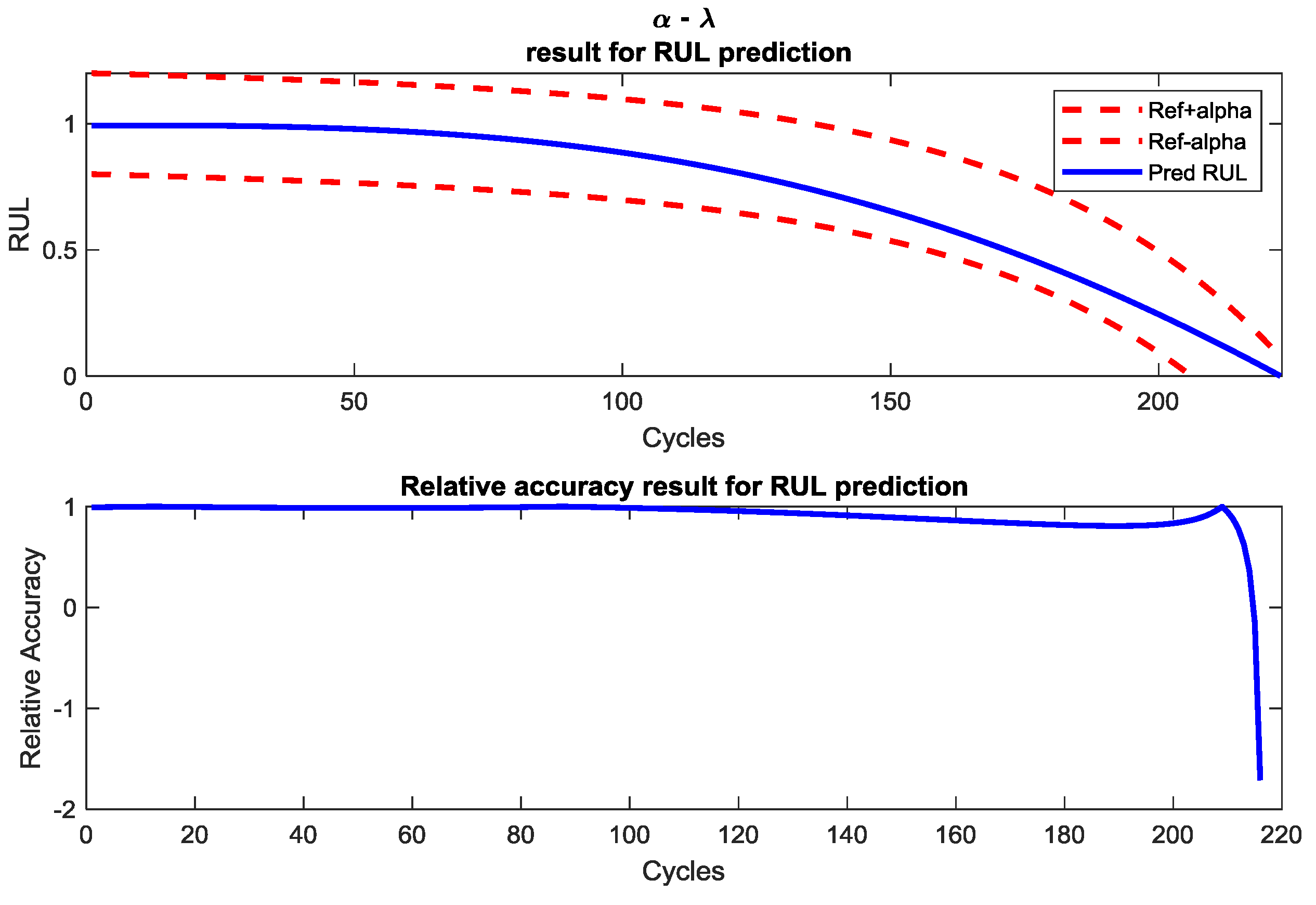
| Sensors | Symbol | Data Set Number | |||
|---|---|---|---|---|---|
| 1 | 2 | 3 | 4 | ||
| Sensor 1 | T2 | 100 | 6 | 95 | 10 |
| Sensor 2 | T24 | 96 | 12 | 100 | 18 |
| Sensor 3 | T30 | 100 | 13 | 94 | 23 |
| Sensor 4 | T50 | 0 | 4 | 0 | 4 |
| Sensor 5 | P2 | 0 | 3 | 15 | 5 |
| Sensor 6 | P15 | 100 | 22 | 100 | 22 |
| Sensor 7 | P30 | 89 | 16 | 97 | 17 |
| Sensor 8 | Nf | 81 | 35 | 94 | 39 |
| Sensor 9 | Nc | 0 | 6 | 4 | 10 |
| Sensor 10 | epr | 100 | 4 | 96 | 13 |
| Sensor 11 | Ps30 | 100 | 19 | 100 | 22 |
| Sensor 12 | phi | 91 | 6 | 94 | 8 |
| Sensor 13 | NRf | 87 | 15 | 93 | 28 |
| Sensor 14 | NRc | 99 | 7 | 100 | 11 |
| Sensor 15 | BPR | 0 | 10 | 0 | 9 |
| Sensor 16 | farB | 99 | 4 | 99 | 11 |
| Sensor 17 | htBleed | 0 | 16 | 0 | 17 |
| Sensor 18 | Nf-dmd | 0 | 0 | 0 | 0 |
| Sensor 19 | PCNfR-dmd | 100 | 5 | 98 | 6 |
| Sensor 20 | W31 | 99 | 4 | 100 | 5 |
| Sensor 21 | W32 | 0 | 0 | 0 | 0 |
Publisher’s Note: MDPI stays neutral with regard to jurisdictional claims in published maps and institutional affiliations. |
© 2022 by the authors. Licensee MDPI, Basel, Switzerland. This article is an open access article distributed under the terms and conditions of the Creative Commons Attribution (CC BY) license (https://creativecommons.org/licenses/by/4.0/).
Share and Cite
Diaf, Y.; Benmoussa, S.; Djeziri, M. Automatic and Generic Prognosis Method Based on Data Trend Analysis and Neural Network. Processes 2022, 10, 1012. https://doi.org/10.3390/pr10051012
Diaf Y, Benmoussa S, Djeziri M. Automatic and Generic Prognosis Method Based on Data Trend Analysis and Neural Network. Processes. 2022; 10(5):1012. https://doi.org/10.3390/pr10051012
Chicago/Turabian StyleDiaf, Youssouf, Samir Benmoussa, and Mohand Djeziri. 2022. "Automatic and Generic Prognosis Method Based on Data Trend Analysis and Neural Network" Processes 10, no. 5: 1012. https://doi.org/10.3390/pr10051012
APA StyleDiaf, Y., Benmoussa, S., & Djeziri, M. (2022). Automatic and Generic Prognosis Method Based on Data Trend Analysis and Neural Network. Processes, 10(5), 1012. https://doi.org/10.3390/pr10051012







